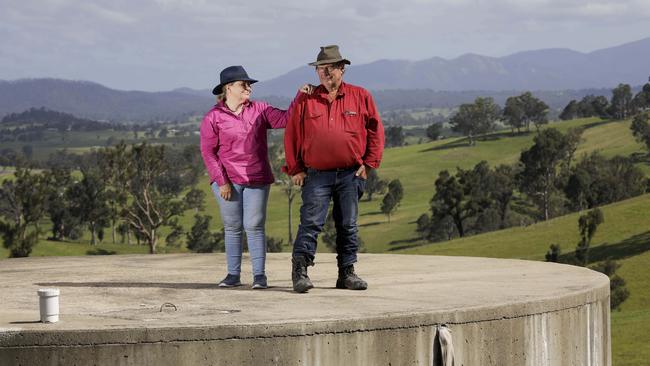Water everywhere, but not to fight the fires
As they contemplate their empty 100,000-litre water tank, Graeme and Robyn Freedman despair at lost opportunities.

As they contemplate their empty 100,000-litre water tank, Graeme and Robyn Freedman despair at the opportunities they have lost.
If they had been able to catch any of this year’s above-average rainfall, they’d be in a position to fight the grass fires they know are coming. But on New Year’s Eve last year, a bushfire destroyed their house in Wandella on the NSW south coast, wiping out the roof areas and other equipment they used to collect rainwater.
“The problem this year is we have four times as much grass and no water, and the fires themselves have pushed weeds and seeds everywhere — so the overgrowth is huge,” Mr Freedman said.
It’s shaping up as a potentially grave problem for NSW in particular, according to the Bureau of Meteorology.
On Thursday, BOM climatologist Greg Browning said the above-average rainfall would continue throughout summer, but he warned that NSW had an increase in fire potential compared to other parts of Australia.
“That’s because that rainfall that they saw earlier in the year has actually produced a lot of grass, and that has the potential to dry out over the coming months and be fuel for potential bushfires,” Mr Browning said.
While severe weather can occur at any time of year, this is the peak period for #bushfires, #heatwaves, #floods and severe #thunderstorms in #NSW.
— Bureau of Meteorology, New South Wales (@BOM_NSW) October 12, 2020
Many thanks in advance to @NSWSES, @NSWRFS & other emergency workers in NSW who help keep us safe https://t.co/fANXVBHQ4I pic.twitter.com/JW0sS9X2kh
For the Freedmans, who have been living in a caravan all year surrounded by abundant grass, it has the makings of a perfect storm.
Mr Freedman said they battled grass fires every year, but they were usually prepared with more than 100,000 litres of water.
“We lost everything in the firestorm,” Ms Freedman said.
“We got out half an hour before the fires came. We lost the sheds, the house, the cattle that grazed on the grass, and the infrastructure with water pipes. Even with all the rain, we have no water.
“We are sitting here in a caravan on the edge of roads that haven’t been cleaned up since the fires last year, so we are right where these grass fires will hit.”
The BOM’s Mr Browning said that in parts of the east coast, particularly in the north and far southeast, there could be a chance of above-average maximum temperatures this summer.
However, he also said most of the country could expect to experience at least a 60 per cent chance of above-average rainfall during the same period.
“That is largely related to the monsoon, where we usually see a pick-up of rainfall and quite warm waters … which could lead to some very high rainfall totals,” Mr Browning said.
“The signal is certainly less pronounced in Queensland, particularly in the east. And much of South Australia is about 50/50.
“Tasmania is really the only area that missed out. But certainly the strongest signal for above-average rainfall is in northern Australia, but all of Australia looks as though it has a good chance of above-average rainfall.”




To join the conversation, please log in. Don't have an account? Register
Join the conversation, you are commenting as Logout